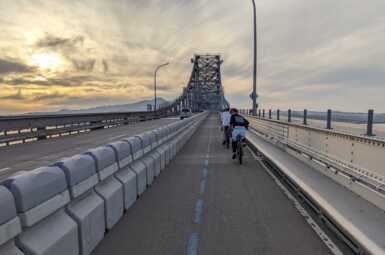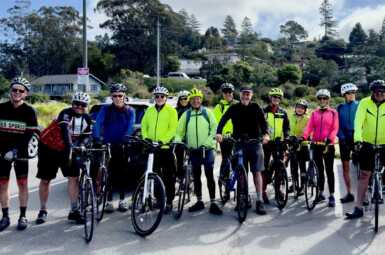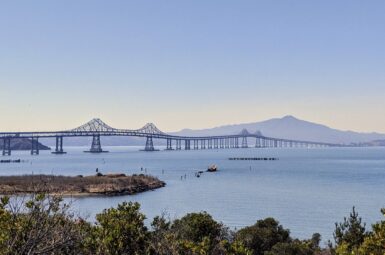November 2020 Election Fairfax Town Council Candidate Questionnaires
As a 501(c)3 nonprofit organization, Marin County Bicycle Coalition cannot endorse candidates for public office, but we are able to share information so that you can arrive at your own conclusion. Below are Fairfax candidates’ responses to our questionnaire on bicycling in Marin. We have made no content changes. Thanks to the candidates for their time and thoughtful answers!
Here are the five candidates vying for three seats on the Fairfax Town Council:
John Reed, Bruce Ackerman, Barbara Coler, Chance Cutrano, Joe McGarry
Do you ride a bicycle? If so, for what purposes and how often? (transportation/road/mtb)
John Reed:
-
Commuting/Errands: 4+ days per week
-
Road: 0-1 days per week
-
Mountain: 2-3 days per week
Bruce Ackerman:
-
Commuting/Errands: 2-3 days per week
-
Road: Never
-
Mountain: Never
Barbara Coler: No response.
Chance Cutrano:
-
Commuting/Errands: 2-3 days per week
-
Road: Never
-
Mountain: Never
Joe McGarry:
-
Commuting/Errands: 4+ days per week
-
Road: Never
-
Mountain: Never
Where does improving bicycling infrastructure and safety rank among your other policy priorities (HIGH / MODERATE / LOW / OTHER)
John Reed: High
Bruce Ackerman: High
Barbara Coler: No response.
Chance Cutrano: High
Joe McGarry: Other: I feel that prior to infrastructure and safety we need to make bicycling in all forms a more equitable activity and mode of transportation.
What’s your vision for the future of transportation in fairfax? What are some of the town’s challenges, and how would you go about fixing them?
John Reed:
Fairfax is a challenging Town, due to narrow streets as well as some residents that fear change. This may well also be the key to improvement.
I believe that electric propulsion will change things phenomenally. Bikes are the most efficient transportation technology on earth. Augment that with electricity (using batteries that are the smallest size used in any transportation method, due to bikes’ small weight). Add in ease of parking, the ability to bypass congestion, and fun, of course. This will increase bike use. Marin has a perfect demographic with it’s windy, hilly roads and healthy population. We are already seeing huge sales in electric bikes, which I believe are poised to change many things. Fairfax has real issues, especially street configuration, which leave little room for dedicated bike lanes in key areas. I am using political opportunities to advance connectivity, as I have done with kids’ Safe Routes to Schools (SR2S) projects during past years, to close these remaining gaps.
From my seat on the Transportation Authority of Marin (TAM), I have advocated repeatedly to embrace this change, among many other bike friendly projects. With several new members to TAM sharing my positions, we now appear to have a majority. This can be seen in the support at board level for increasing the extension of the North-South Greenway, as well as support for the Cross Marin Bikeway, and efficient Bike bypasses of barriers in Mill Valley and the Hub in San Anselmo. While this does of course still require the ongoing advocacy of organizations like MCBC, it looks like we now have the votes to get things done!
Bruce Ackerman:
A combination of rideshare (eventually some automated), walking and bicycling, and possibly hyperlocal vans in neighborhoods, all connecting with transit for longer trips. All vehicles being either human-powered or electric.
A challenge in implementing this is of course the attitude by citizens (and the agencies that represent them, e.g. TAM) that the top priority is always to preserve the automobile. As I look far enough forward to envision automated vehicles, I see the possibilities of either utopian or dystopian futures. My thinking is consistent with the book Three Revolutions, out of UC Davis.
Barbara Coler: No response.
Chance Cutrano:
The pandemic has changed our work commutes and reduced overall vehicle-miles-traveled throughout the Bay Area. We have an incredible opportunity to reimagine transit post-COVID, but it will require renewed and coordinated education, encouragement, evaluation and engineering to increase ridership across all demographics.
1. E-bikes, for instance, are unlocking a new opportunity to promote active transportation and complete streets with exceptional bike/ped infrastructure. How can we incentivize e-bikes like electric cars?
2. Potential new riders can be supported with new adult cycling classes offered through our Parks and Rec department (in partnership with MCBC?).
3. I’d like to be part of the coordinated efforts with the Transportation Authority of Marin and other regional bodies to review the share of transit dollars spent on cycling programs and infrastructure.
4. The solutions to our bicycling challenges are, in many cases, held by the people biking in our town. I’d like to engage with these riders and make sure their voices and visions are captured in our planning meetings.
Joe McGarry:
I think we need to specifically look at the ability to commute to work by bike. In Fairfax our essential services and food/beverage industry is held up by people who are mostly commuting a long ways to work and in many cases crossing bridges. The idea of using a bike to commute is just not an option. We need to address affordable housing for these people in town (or closer to town) so that biking can become a possibility for their commutes.
Covid-19 has dramatically impacted transportation, with fewer cars on the road, but also fewer people riding transit. How will you work to ensure that recovery efforts include sustainable and equitable transportation outcomes, especially for those most reliant on transit?
John Reed:
I have advocated as a TAM Commissioner that Marin Transit retrofit their ventilation system (exhaust vents at windows, and plexiglass partitions) to allow more ridership, taking into account the cultural challenges of specific rider groups (not wanting open windows in a moving vehicle.) I have met with resistance to my proposal on financial grounds. My ideas may get another look, due to push-back from union drivers who are reacting to MTC’s solution of merely adopting a 3 foot rule vs. the standard 6 foot one. This is an evolving situation.
I have and will continue to advocate increasing bike rack capacity and security on buses and trains, and at stations, to facilitate expansion in these areas.
Bruce Ackerman:
Transit has always required public subsidy, but if ridership doesn’t rebound it will require much more. So obviously try to get people to ride. The possible lingering fear of being in public after the Covid experience could be really terrible not only for transit but for ride-sharing.
Barbara Coler: No response.
Chance Cutrano:
We are at a truly unique moment. Alongside the pandemic, we are updating our Climate Action Plan here in Fairfax. Soon we will be starting up discussions around our General Plan update. I will be centering sustainability and equity in all of these conversations. That starts with robust research on the most current best practices and models we can replicate. It also means listening. This will be an important opportunity to connect with our cycling community and revisit our bike plan to ensure it is current and being implemented. Through this process, we could be advocating for an active bicycle advisory committee in Fairfax to support Town Council in making decisions that will create a more Bicycle-centric Marin.
Joe McGarry:
As an essential worker I have experienced firsthand how our county in not set up to serve those who provide the most essential services in an equitable way. Essential workers rely on public transportation and I will be centering all of the needs of these workers who have held this county up through COVID-19, including prioritizing their need for reliable and safe public transportation.
If elected, what would you do to 1) improve safety for all people who ride bikes and 2) increase the number of people who bike for transportation? Please note any infrastructure projects in fairfax that you think are particularly important.
John Reed:
1) continue to advocate for closing the bike lane gap on Broadway in downtown. Install charging stations for electric bikes in downtown, along with more bike parking. 2) promote bike parking and route infrastructure, as well as tout the benefits, and lead by example!
Bruce Ackerman:
I lean towards using small connectors, e.g. Mono Alley in Fairfax, to help young kids get through the town center. Azelia crosswalks are coming soon. Beyond this, the biggest thing that improves safety is having more bicyclists, so drivers get more used to them — and I’m so happy that this seems to be continuing to happen.
Barbara Coler: No response.
Chance Cutrano:
I’d like to work closely with the bicyclist community to discern priority routes that require new or improved bike lanes to improve safety. For instance, we currently lack sufficient bike lanes on our arterial streets (Center, Broadway, Bolinas, etc)
Right now we should be getting creative around programs that encourage new and emerging riders. As mentioned above, COVID has encouraged residents to rethink how they get around, how they recreate safely, and the necessity of multi-car households (now that that home office is broken in!) I’d like to play a more active role in promoting bicycle events (bike month, bike to work events, etc.). I’d like to partner with our cycling stakeholders to develop programs that will encourage and inform the next generation of bicyclists.
Joe McGarry:
1) We need to address the issue of a disproportionate amount of police stops of Black and Latinx people riding bikes. We need cycling to be an equitable activity and that includes ensuring Black, Indigenous, and People of Color can ride without fear of being pulled over.
2) I feel strongly that we need to make cycling a more equitable and inclusive recreational activity for BIPOC in Marin. Those who are given access to the joys and health benefits of biking with family and friends will be more inclined to explore using a bike as a primary form of transportation.
Why should people who ride bikes vote for you?
John Reed:
I have long been a bike advocate, well before sitting on the Fairfax Council. I was instrumental in piloting SR2S’s start in Fairfax with Deb Hubsmith. I have gotten much of the current infrastructure in Fairfax built. I will continue in this role, both in Fairfax and regionally through my role as a Commissioner on TAM.
Bruce Ackerman:
Because I have been a cyclist all my life (in earlier years for long distances, riding from city to city); I have designed and made bicycle carts in both Massachusetts and Arizona, and ridden many long trips pulling them; and I still have that vision intact, even more urgent with climate change, that bicycles and not e-bikes are the most efficient and wonderful form of transportation.
Barbara Coler: No response.
Chance Cutrano:
As an environmentalist, few things are as critical as solving the “elephant in the room” of transit-related greenhouse gas emissions reductions. I believe bicycles play a critical role in the future of Fairfax, and in our efforts to combat climate change. I take my role as a listening leader seriously and I’m committed to collaborating with the bicycle community to get the work done. If you have ANY suggestions or thoughts about how to make our community more bike-friendly please reach out via e-mail or a phone call.
Joe McGarry:
My family and I are bike riders who enjoy the health and bonding that biking provides us. I am privileged to work and live in the town of Fairfax and use my bike to commute to work. I will work tirelessly for those who have been marginalized by policy in Marin, those who don’t get to fully experience biking, so that bicycling can become an equitable and inclusive activity and mode of transportation for all Black, Indigenous, and People of Color who live, work and visit Fairfax.
members make it happen!
We’re fighting for a more bike-friendly future in Marin. Are you with us? Join Marin County Bicycle Coalition today.



